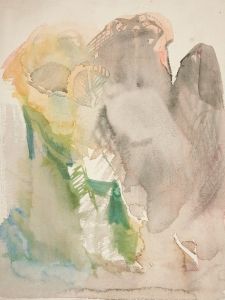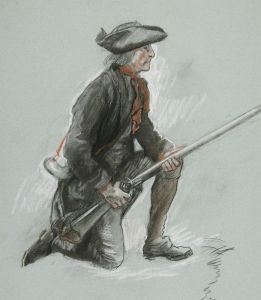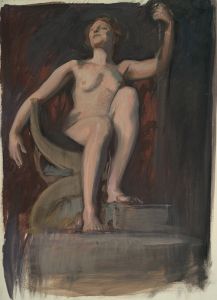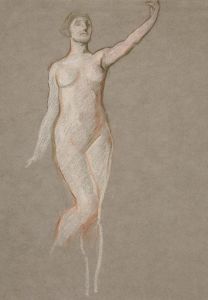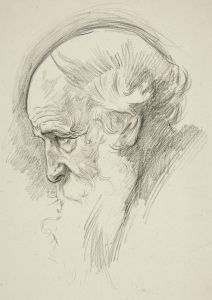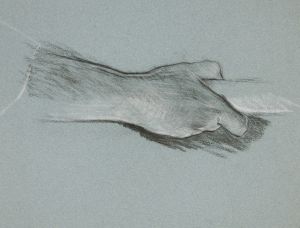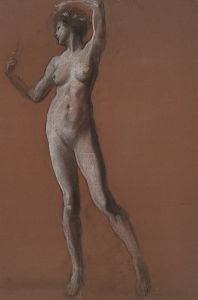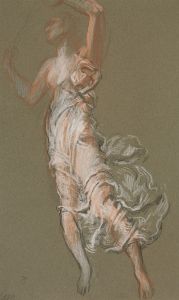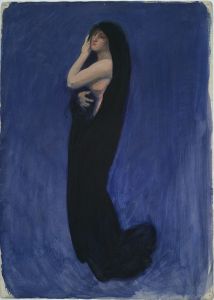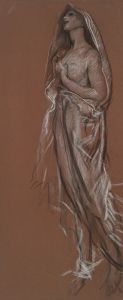
Figure Study, for The Spirit of Light, Rotunda, Pennsylvania State Capitol, Harrisburg
A hand-painted replica of Edwin Austin Abbey’s masterpiece Figure Study, for The Spirit of Light, Rotunda, Pennsylvania State Capitol, Harrisburg, meticulously crafted by professional artists to capture the true essence of the original. Each piece is created with museum-quality canvas and rare mineral pigments, carefully painted by experienced artists with delicate brushstrokes and rich, layered colors to perfectly recreate the texture of the original artwork. Unlike machine-printed reproductions, this hand-painted version brings the painting to life, infused with the artist’s emotions and skill in every stroke. Whether for personal collection or home decoration, it instantly elevates the artistic atmosphere of any space.
Edwin Austin Abbey, an American muralist and illustrator, is renowned for his significant contributions to the art world during the late 19th and early 20th centuries. One of his notable works is the "Figure Study, for The Spirit of Light, Rotunda, Pennsylvania State Capitol, Harrisburg." This piece is part of a larger project that Abbey undertook for the Pennsylvania State Capitol, which was completed in the early 1900s.
Abbey was commissioned to create a series of murals for the Pennsylvania State Capitol in Harrisburg, a project that was part of a broader initiative to adorn the building with artworks that reflected the history and values of Pennsylvania. The Capitol itself, designed by architect Joseph Miller Huston, is a Beaux-Arts masterpiece, and Abbey's murals were intended to complement its grandeur and architectural elegance.
The "Figure Study, for The Spirit of Light" is a preparatory work for one of the murals in the Rotunda of the Capitol. Abbey's murals in the Capitol are celebrated for their allegorical and historical themes, often depicting scenes that embody the spirit of enlightenment, progress, and the rich history of Pennsylvania. The "Spirit of Light" is one such theme, symbolizing knowledge, wisdom, and the enlightening power of education and innovation.
Abbey's approach to mural painting was meticulous and detailed. He often created numerous sketches and studies before finalizing the composition for his murals. These preparatory works, such as the "Figure Study," provide insight into his creative process and the evolution of his ideas. They reveal his attention to detail, his understanding of human anatomy, and his ability to convey complex themes through allegorical figures.
The murals in the Pennsylvania State Capitol, including the "Spirit of Light," are executed in the grand manner style, characterized by their large scale, dramatic compositions, and use of symbolism. Abbey's work in the Capitol is considered one of his crowning achievements and contributes significantly to the building's status as a national historic landmark.
Abbey's contribution to the Pennsylvania State Capitol was part of a larger trend during the American Renaissance, a period when artists and architects sought to create works that reflected the nation's ideals and aspirations. His murals are not only artistic masterpieces but also serve as historical documents that capture the spirit of the era.
Unfortunately, Abbey did not live to see the completion of his work in the Capitol. He passed away in 1911, and his work was completed posthumously by other artists. Despite this, his influence and vision are evident in the final murals, which continue to be admired by visitors to the Capitol.
In summary, Edwin Austin Abbey's "Figure Study, for The Spirit of Light, Rotunda, Pennsylvania State Capitol, Harrisburg" is a testament to his skill as a muralist and his ability to convey profound themes through art. His work in the Pennsylvania State Capitol remains a significant contribution to American art and continues to inspire appreciation for its historical and cultural significance.





